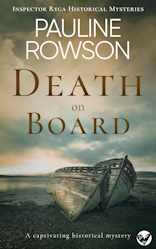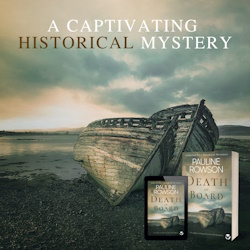
When it comes to writing my 1950s set historical crime series I’ve been extremely fortunate to work with some very interesting and obliging people — including former police officers of the 1950s era — who have helped me with police procedure, attitudes and location research.
My Inspector Ryga mysteries are set in real coastal locations around the UK that looked very different in the 1950s to today, so maps from that period are studied in great detail, courtesy of the National Library of Scotland ordnance survey maps collection.
I’ve also become something of a train and bus timetable freak, using the Timetable World website, which I can get lost in for hours, and end up lamenting the loss of so many great railway and bus services in Britian. I make sure I can get Ryga, and the other characters, to places they need to be because there were so few cars. And bobbies were indeed on bicycles — and foot — in the 1950s.
Getting the historical facts right is a challenge, but I enjoy it. It is quite surprising the things we now take for granted. For example, I had one of my characters dunking a tea bag in a mug before I thought hold on, were tea bags around in the UK in 1950, and were they in general use? The answer to both is no. They were in use in America, but didn’t go on sale in the UK until 1953. I also had to check rationing because I couldn’t have someone liberally applying butter to a piece of toast when butter was still being rationed in the UK until 1953!
The 1950s is an intriguing period to base my detective, Inspector Alun Ryga, who is sent from Scotland Yard to investigate coastal crimes predominantly in the south of England. Ryga’s experience as a former merchant seaman, and his ordeal as a German prisoner of war, has made him unique in his approach to solving crimes. He’s observant, analytical and reflective. He’s witnessed compassion, cruelty, cowardice and heroism, mental breakdown and despair. He’s made a promise to himself that whatever happens after the war, he’ll keep an open mind and never judge.
 May 1951.
May 1951.
Inspector Alun Ryga surveys the wreckage of the break in at the elegant Harley Street drawing room, home of retired dermatologist Sir Bernard Crompton, who’s currently sailing his new yacht down the British coast from Scotland — or he was . . .
Sir Bernard is found dead on board his boat off the coast of Cornwall and Ryga is despatched to investigate the circumstances surrounding it, even though the Chief Constable doesn't want him there and the doctor has declared he died of natural causes.
But Sir Bernard had contacts in high places. And there is that break in at his house.
Ryga is puzzled to learn that Crompton was wearing a dinner suit with five rocks in his pocket.
The case takes a deadly turn when another body is found in a nearby cove with a gunshot wound to the face. The victim is also wearing a dinner suit with rocks in his pocket.
Is there a past connection between the two men? Why does no one want Ryga to find the killer?
As he doggedly continues, and more disturbing facts come to light, Ryga, haunted by his wartime memories begins to empathise with the community; he struggles to get a grip on the case. Will he fail to solve it? Does it matter if he does?
All his ability, patience and impartiality are put to the test in DEATH ON BOARD. Will he come through it and find the killer?
On Amazon Kindle, Kindle Unlimited and paperback
Pauline Rowson lives on the South Coast of England and is the best selling author of many crime novels, published by Joffe Books. Her popular crime novels include the DI Andy Horton Solent Murder Mystery series, the Art Marvik mystery thrillers and the 1950s set Inspector Ryga mysteries. Subscribe to her newsletter for all the latest books news.